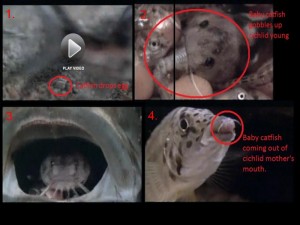Source: Mouth Brooding Fish, available: http://video.nationalgeographic.com/video/player/animals/fish-animals/spiny-rayed-fish/cichlid_movingyoung.html
The mochokid catfish, Synodontis multipunctatus, lay their eggs in the territories of the cichlids and knowing that the cichlid mother will pick them up, assuming that they are her own. She then becomes the surrogate mother to a predator. The catfish eggs hatches first and feeds on the cichlid babies. Interestingly, the cichlid mother treats the catfish as her own. (See picture above for brief illustration)
Through the extended interactions, the mochokid catfish, S. multipunctatus, probably learned that the cichlids are “extremely reliable parents” which protect their young by mouthbrooding (Tetsu, 1986)—the holding of their offspring in their mouths in face of danger, acting like a “nest and nursery”. Such cleverly exploitation by the catfish will almost warrant survival of their kind, at least in evolutionary terms.
References
Tetsu, S. (1986) A brood parasitic catfish of mouthbrooding cichlid fishes in Lake Tanganyika. Nature, 323: 58-59.
“Mouth Brooding Fish” by National Geographic. URL: http://video.nationalgeographic.com/video/player/animals/fish-animals/spiny-rayed-fish/cichlid_movingyoung.html (accessed on 06 April 2010)

